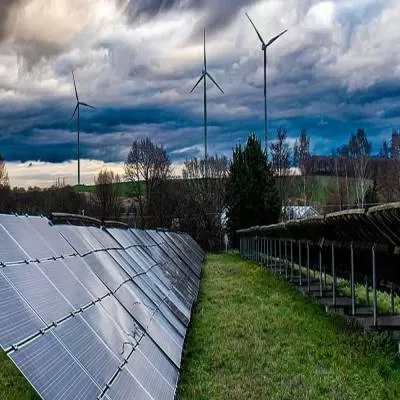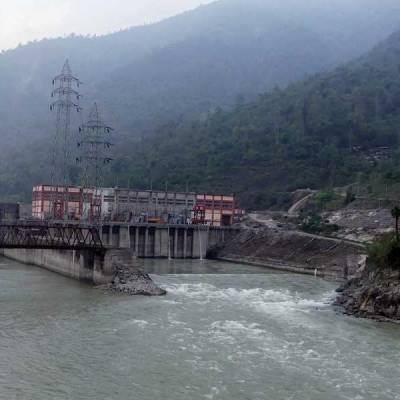- Home
- Infrastructure Energy
- POWER & RENEWABLE ENERGY
- Act on Environment

Act on Environment
The courts have generally followed a policy of non-interference in litigations against large infrastructure projects. Not ordering cancellation of major projects or mandating major restructuring work in the face of stiff opposition, the courts have taken the stand that technical issues and policy matters arising from economic standpoints on account of environmental effects are best left to the discretion of expert committees constituted by the executive.
There have been cases where the apex court has been forced to step in and issue diktats to protect the environment. A key instance of this is the landmark judgement passed by the Supreme Court on a writ petition filed on behalf of the Indian Council of Enviro-Legal Action (ICELA), which mandated states to conceive coastal management plans within a set timeframe and banned construction and industrial activity within 500 m of the High Tide Line and implement the provisions of the Coastal Regulation Zone notification of 1991 in its entirety.
Protecting environmental assets
To protect its environmental assets and preserve its natural resources, India has deployed a broad range of regulatory instruments. The responsibility for protecting the environment has been fixed upon the states through the Constitution (Forty-Second Amendment) Act, 1976. Article 48-A (xiv), Article 51-A (g) (xv) and Article 51-A (g). In attempting to maintain the thin balance to foster development and protect the environment, policymakers have framed special enactments and laws and empowered governing bodies and tribunals to assess the impact of rapid urban and industrial growth on the environment by making provisions for environmental clearances, safety measures, environmental safeguards and provisions mandated under various acts.
Environmental (Protection) Act, 1986 (EPA) Measures for protecting ecologically sensitive environmental assets are periodically issued by the Central Government under the EPA. Notifications issued under this Act include:
ò Doon Valley Notification (1989): Notification under 3(2)(v) of Environment (Protection) Act, 1986, and Rule 5(3)(d) of Environment (Protection) Rules, 1986, restricting location of industries, mining operations and other development activities in the Doon Valley in Uttar Pradesh. Imposed restrictions and made prior permission from the concerned department necessary before carrying on location/siting of industrial units, mining, tourism and grazing, etc.
Coastal Regulation Zone Notification (1991): The country's first CRZ notification was issued in 1991 under the Environment Protection Act. The Act was formulated as a bulwark to moderate industrial activities along India's 7,500 km coastline and conserve the fragile coastal region along with protecting livelihoods. The Act has undergone 25 amendments before a comprehensive revision was formulated in 2011.
The Environmental Impact Assessment of Development Projects Notification (1994 and as amended in 1997): The notification stipulates:
- The Ministry of Environment and Forests (MoEF) has to issue environmental clearance for all projects listed under Schedule I.
- MoEF needs to approve projects under the delicensed category of the New Industrial Policy.
- MoEF clearance is mandatory for developmental projects in fragile regions, irrespective of the fact whether or not they are categorised under Schedule I.
- Industrial projects with investments exceeding Rs 500 million are mandated to obtain MoEF clearance and obtain a Letter of Intent (LoI) from the Ministry of Industry and a NOC from the State Pollution Control Board (SPCB) and the State Forest Department if the concerned location is notified as a forest land. After obtaining the NOC, the state authority converts the LoI into an industrial license.
Environmental Impact Assessment (EIA):
The process of EIA has been devised to assess the expected effects (positive or negative) of a proposed development or project on the environment. Most EIA processes operate on common structural guidelines and their implementation is based on good standards and ethical practices.
The procedure of carrying out EIA processes comprises eight steps with every step equally important in reviewing the performance of a project. The steps are as follows:
Screening: This is the first stage in which it can be ascertained whether a particular project needs to undergo EIA and, if yes, what the level of assessment should be. Scoping: After the initial stage, there emerges the need for further investigating of pertinent issues and impact. In this stage, the boundary and the time limit within which the study needs to be concluded are largely decided.
Impact analysis: This stage involves the identification and accurate prediction of the possible environmental and social impact of a proposed project.
Mitigation: After the ensuing impacts on a project are identified, actions to mitigate the possible environmental adversities arising from developmental activities are mulled over.
Reporting: At this stage, a report elucidating the result areas of the EIA are presented to the concerned decision-making body or other relevant authorities.
EIA review: This stage reviews how adequate and effective the EIA report has been and provides the pertinent information required to facilitate the decision-making process.
Decision-making: This is a crucial stage, which decides whether a project should be given the stamp of approval, rejected or additionally modified.
Post-monitoring: This is the post-project commissioning stage. During this phase, checks are carried out to ensure that project impacts do not overstep legal standards and mitigation measures adhere to prescribed steps as mentioned in the EIA report.
EIA guidelines in India
The Environment (Protection) Act 1986 has made EIA mandatory for 29 categories of developmental activities with investments of Rs 50 crore and above. Expert committees have been constituted to provide environmental appraisals encompassing mining projects, industrial projects, thermal power projects, river valley, multipurpose, irrigation and hydroelectric projects, infrastructure development and miscellaneous projects along with nuclear power projects.
Various EIA project guidelines have been issued by the Department of Environment (DoE) since its formation in 1980. As per present EIA guidelines, project authorities present a DPR to the MoEF with the requisite information in the specified format along with the EIA studies, environmental impact statements (EIS) and environmental management plans (EMP). The Expert Committee then considers the project and takes a decision on its sanction based on established environment parameters.
Keeping in view the environmental concerns and that the courts, in the exercise of their jurisdiction, will not transgress into the field of policy decision, National Green Tribunal has been established for effective and expeditious disposal of cases relating to environmental protection. It is a specialised body equipped with the necessary expertise to handle environmental disputes involving multi-disciplinary issues.
About the author:
Jagriti Ahuja is an associate with SNG & Partners and is a part of the litigation team within the firm.
JAGRITI AHUJA lays emphasis upon the role of regulatory planning in fostering environmental protection. The courts have generally followed a policy of non-interference in litigations against large infrastructure projects. Not ordering cancellation of major projects or mandating major restructuring work in the face of stiff opposition, the courts have taken the stand that technical issues and policy matters arising from economic standpoints on account of environmental effects are best left to the discretion of expert committees constituted by the executive. There have been cases where the apex court has been forced to step in and issue diktats to protect the environment. A key instance of this is the landmark judgement passed by the Supreme Court on a writ petition filed on behalf of the Indian Council of Enviro-Legal Action (ICELA), which mandated states to conceive coastal management plans within a set timeframe and banned construction and industrial activity within 500 m of the High Tide Line and implement the provisions of the Coastal Regulation Zone notification of 1991 in its entirety. Protecting environmental assets To protect its environmental assets and preserve its natural resources, India has deployed a broad range of regulatory instruments. The responsibility for protecting the environment has been fixed upon the states through the Constitution (Forty-Second Amendment) Act, 1976. Article 48-A (xiv), Article 51-A (g) (xv) and Article 51-A (g). In attempting to maintain the thin balance to foster development and protect the environment, policymakers have framed special enactments and laws and empowered governing bodies and tribunals to assess the impact of rapid urban and industrial growth on the environment by making provisions for environmental clearances, safety measures, environmental safeguards and provisions mandated under various acts. Environmental (Protection) Act, 1986 (EPA) Measures for protecting ecologically sensitive environmental assets are periodically issued by the Central Government under the EPA. Notifications issued under this Act include: ò Doon Valley Notification (1989): Notification under 3(2)(v) of Environment (Protection) Act, 1986, and Rule 5(3)(d) of Environment (Protection) Rules, 1986, restricting location of industries, mining operations and other development activities in the Doon Valley in Uttar Pradesh. Imposed restrictions and made prior permission from the concerned department necessary before carrying on location/siting of industrial units, mining, tourism and grazing, etc. Coastal Regulation Zone Notification (1991): The country's first CRZ notification was issued in 1991 under the Environment Protection Act. The Act was formulated as a bulwark to moderate industrial activities along India's 7,500 km coastline and conserve the fragile coastal region along with protecting livelihoods. The Act has undergone 25 amendments before a comprehensive revision was formulated in 2011. The Environmental Impact Assessment of Development Projects Notification (1994 and as amended in 1997): The notification stipulates: - The Ministry of Environment and Forests (MoEF) has to issue environmental clearance for all projects listed under Schedule I. - MoEF needs to approve projects under the delicensed category of the New Industrial Policy. - MoEF clearance is mandatory for developmental projects in fragile regions, irrespective of the fact whether or not they are categorised under Schedule I. - Industrial projects with investments exceeding Rs 500 million are mandated to obtain MoEF clearance and obtain a Letter of Intent (LoI) from the Ministry of Industry and a NOC from the State Pollution Control Board (SPCB) and the State Forest Department if the concerned location is notified as a forest land. After obtaining the NOC, the state authority converts the LoI into an industrial license. Environmental Impact Assessment (EIA): The process of EIA has been devised to assess the expected effects (positive or negative) of a proposed development or project on the environment. Most EIA processes operate on common structural guidelines and their implementation is based on good standards and ethical practices. The procedure of carrying out EIA processes comprises eight steps with every step equally important in reviewing the performance of a project. The steps are as follows: Screening: This is the first stage in which it can be ascertained whether a particular project needs to undergo EIA and, if yes, what the level of assessment should be. Scoping: After the initial stage, there emerges the need for further investigating of pertinent issues and impact. In this stage, the boundary and the time limit within which the study needs to be concluded are largely decided. Impact analysis: This stage involves the identification and accurate prediction of the possible environmental and social impact of a proposed project. Mitigation: After the ensuing impacts on a project are identified, actions to mitigate the possible environmental adversities arising from developmental activities are mulled over. Reporting: At this stage, a report elucidating the result areas of the EIA are presented to the concerned decision-making body or other relevant authorities. EIA review: This stage reviews how adequate and effective the EIA report has been and provides the pertinent information required to facilitate the decision-making process. Decision-making: This is a crucial stage, which decides whether a project should be given the stamp of approval, rejected or additionally modified. Post-monitoring: This is the post-project commissioning stage. During this phase, checks are carried out to ensure that project impacts do not overstep legal standards and mitigation measures adhere to prescribed steps as mentioned in the EIA report. EIA guidelines in India The Environment (Protection) Act 1986 has made EIA mandatory for 29 categories of developmental activities with investments of Rs 50 crore and above. Expert committees have been constituted to provide environmental appraisals encompassing mining projects, industrial projects, thermal power projects, river valley, multipurpose, irrigation and hydroelectric projects, infrastructure development and miscellaneous projects along with nuclear power projects. Various EIA project guidelines have been issued by the Department of Environment (DoE) since its formation in 1980. As per present EIA guidelines, project authorities present a DPR to the MoEF with the requisite information in the specified format along with the EIA studies, environmental impact statements (EIS) and environmental management plans (EMP). The Expert Committee then considers the project and takes a decision on its sanction based on established environment parameters. Keeping in view the environmental concerns and that the courts, in the exercise of their jurisdiction, will not transgress into the field of policy decision, National Green Tribunal has been established for effective and expeditious disposal of cases relating to environmental protection. It is a specialised body equipped with the necessary expertise to handle environmental disputes involving multi-disciplinary issues. About the author: Jagriti Ahuja is an associate with SNG & Partners and is a part of the litigation team within the firm.




















